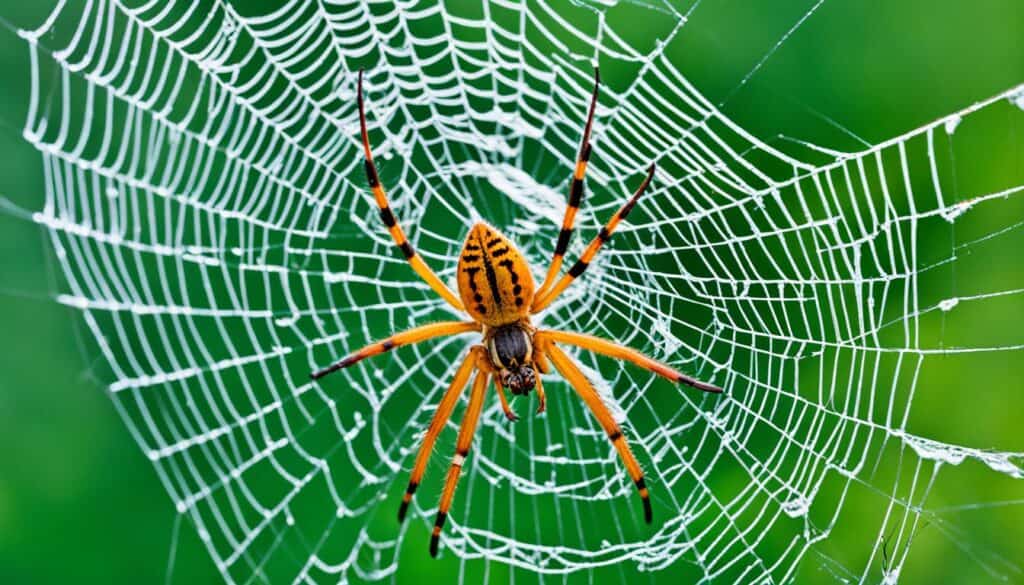Did you know that the Joro spider’s territory in the U.S. spanned over 120,000 square kilometers by October 2022? These eight-legged creatures have legs up to 4 inches long. Their yellow and black bodies have sparked fear from Georgia to Tennessee. They may even reach New York! The invasion worries many about its effect on the East Coast’s nature.
Imagine seeing these colorful spiders weaving golden webs around your home. This sight is now common in states like Georgia and Tennessee. Reports of Joro spiders are coming from as far as Alabama and West Virginia. Experts worry their hunting skills may harm the ecosystem. They spread quickly using a technique called “ballooning.”
Since 2010, Joro spiders have been in north Georgia. The concern has grown a lot since 2021. Experts think they might spread to New York. They could harm local bugs, which affects the ecosystem. Still, they are not dangerous to people or pets.
Key Takeaways
- The Joro spider’s range covered 120,000 square kilometers across several states by October 2022.
- Introduced to north Georgia around 2010, these spiders are spreading up the East Coast.
- Notable states with Joro spider sightings include Alabama, Maryland, Oklahoma, and West Virginia.
- Reports of increased sightings in Georgia started in 2021, alarming local residents.
- Ballooning technique helps Joro spiders move into new territories rapidly.
Understanding the Joro Spider: Origins and Characteristics
The Joro spider is a sight to see. It comes from Southeast Asia and has a unique yellow and black design. They likely arrived in North Georgia around 2013 or 2014. They probably hitched a ride on a ship from Japan, China, Taiwan, or Korea. Since then, they’ve been hard to miss.
These spiders can grow three inches long. They have been spreading through northern Georgia and South Carolina. Their golden webs can be up to 10 feet wide. It’s no wonder they’re so noticeable with their impressive weaving skills.
Joro spiders use a cool method, called “ballooning,” to move around. They use silk threads to catch the wind and glide to new places. This can take them 50-100 miles away. It’s like they’re performing nature’s own tightrope act.
Experts at the University of Georgia believe Joro spiders might expand across the East Coast. Although they’re not aggressive, their bite feels like a bee sting. Yet, their striking yellow and black legs are a clear warning to stay back.
It’s the younger Joro spiders that go ballooning. By September, they mature and lay 400-1,500 eggs. This happens just in time for the spooky season. They mate, spread their eggs, and finish their life cycle by late November.
Even though Joro spiders are not native, they help by eating pests. They like to feast on the brown marmorated stink bug, a crop pest. So, these spiders are not just scary. They play a helpful, yet complex, role in our ecosystem.
Regions Affected by Joro Spiders
Let’s talk about the *overachievers* of the spider world – the Joro spiders. They have claimed Atlanta as their East Coast base. With goals, ambition, and lots of silk, they’re on the move. Georgia was just the start. Now, they’re spreading into the Carolinas and Southeastern Tennessee. It seems they aim to take over the Southeast.
These eight-legged adventurers have a solid plan. They use “ballooning” to travel, catching the wind to move around. Hence, they pop up in unexpected places. They’ve even been spotted as far north as Maryland. This shows they’re expanding Northeast.
Why are these sightings increasing? Joro spiders adapt well, handling cold better than other spiders. This resilience lets them move beyond the Southeast. Whether it’s the mild conditions in Tennessee or cooler Baltimore, they adapt and thrive.
The surprising fact is they get help from us. Joro spiders don’t just rely on the weather to spread. They can travel by cars, hide in luggage, or jump onto shipping containers. Therefore, their spread isn’t slowing down. With their strong nesting instincts, they’re making homes wherever they find themselves. Their goal to dominate the East Coast is clearly proceeding.
Why the East Coast is Vulnerable
Ever wondered about the East Coast’s new unwanted guests? We’re talking about the Joro spider. This critter, originally from Japan, found a new home on the East Coast. It arrived in the U.S. around 2013, quickly settling in Georgia and the Southeast. The climate and environment here closely match its homeland. It’s like they never left Japan, just without the language difference.
Climate change is making the East Coast more inviting for these spiders. Add in global trade, and you’ve got the perfect storm for these invaders. These spiders aren’t just lounging around. They adapt well to the cold, thanks to their robust metabolism and heart rate. They’re the ultimate survivors of winter.
Human movement also plays a role in spreading these spiders. As we travel, we inadvertently help them move. Once they settle, they begin competing with local species, potentially harming the ecosystem. They’re like the guests who never leave.
Research from the University of Georgia shows the Joro spider’s resilience. It’s capable of surviving the cold, possibly spreading along the Eastern Seaboard. They can even ‘balloon’, traveling on the wind with their silk. Spiders just got a bit more unsettling, didn’t they?
The East Coast, known for its beaches and breezes, is now a playground for Joro spiders. Climate change and global trade are to blame. It seems they’re here to stay. So, the East Coast faces a new threat: an invasion of Joro spiders.
Impact on Native Species and Local Ecosystems
The Joro spider is making its mark since it arrived in the U.S. in 2013. It’s been moving across the Southeast. What makes this interesting is a study by the University of Georgia. It says these spiders can handle cold because of their fast metabolism and high heart rate.
Talking about spider metabolism might seem odd. Yet, the Joro spider’s energy and heart rate are much higher than its relatives. This has caught the attention of scientists and those of us interested in intense diets. These spiders can also survive cold snaps, which might help them move further east.
Do Joro spiders hurt local ecosystems? It seems they don’t cause big problems. They do eat a lot of insects but don’t mess up food chains much. The issue is they compete with native spiders, like orb-weavers, which might change the ecosystem.
There’s a chance these spiders could fight off pests like the spotted lanternfly. But no one thinks they’ll be a fix-all solution. Their real skill is moving far by catching air with silk threads. This, combined with global trade, extends their impact. They won’t take over, but we should watch these colorful spiders.




